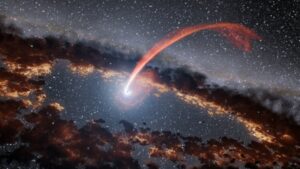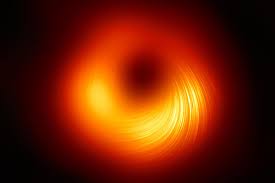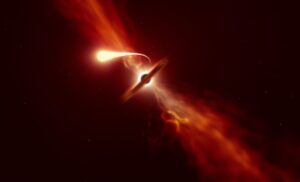How blackholes are affecting the earth
How blackholes are affecting the earth. According to NASA science solar system exploration, a black hole is located in space and is made up of dense objects that are impermeable to light. Black holes are centers of massive gravitation due to a lot of mass being compressed in a minute space, which results in an object that breaks the fabric of time and space, resulting in “singularity”. The gravity from a black hole is very powerful in that it can “eat” a nearby material. Black holes are called so because the gravity in their core is very strong such that it siphons nearby light, none escaping. According to scientists, black holes are places where you can find the greatest gravitational pull in a universe, thus it is detrimental to try to come close to one. If you come too near to the one you might end up in the point of no return which is referred to as “the event horizon”. This is because the gravity is so high that you would never escape even while traveling at the speed of light.
How blackholes are affecting the earth
Black holes can also cause spaghettification to a star like earth
Black holes can also cause spaghettification to a star like earth. Spaghettification is the conversion of a star into spaghetti chips. This occurs as a star approaches a black hole, one side gets pulled more than the other because one side is nearer, this results in more gravitational pull from one side (the one facing the black hole) resulting in a tidal force that pulls apart the star much like preparing spaghetti from pasta dough. Astronomers have seen this on other universes and they refer to it as a “tidal disruption event” which is merely a star being torn apart due to its closeness with the black hole. Luckily for us, there is no black hole which is near earth. V616 monocerotis (a0620-00) is the only known black hole that is near earth although not near enough to harm us. It is 6 times larger than our sun, therefore possesses a greater gravitational pull. Hypothetically if the earth were to come within 3.7 light seconds (800,000 km) of it would get torn apart. V616 monocerotis is too far away to harm us in our lifetime.
a star turning into spaghettis chips.
Stellar tidal disruption
When a star passes too close to a black hole there is stretching and compression of the stellar material which destroys a star called “stellar tidal disruption,” and results in the release of immense energy that causes a “flare” or a very bright surrounding. A few flares have been observed in recent years and astronomers are trying to discern. Nasa’s wide-field infrared survey explorer (wise) contains data that is being used by astronomers to study tidal disruptions. Wise data show how tidal disruptions happen by observing how dust particles surrounding the blackholes absorb and emit light in an echo-like form. This has given scientists the ability to quantitate the stellar tidal reflection energy flares surpassing earlier technologies. WSW is operated and managed by JPL in the NASA missions in Washington DC. The spacecraft scanned the whole sky twice hence completing its sole function thus was hibernated in 2011, it was however reactivated in 2013 to assist nasa to scan near-earth objects that might be dangerous.
Stellar tidal disruption

How blackholes are affecting the earth
Quasars are essential for galaxies to be born
Quasars are essential for galaxies to be born, quasar activity leads to the formation of supermassive black holes, a quasar is an immense black hole with an accretion disk surrounding it. When stars and galaxies are pulled into a quasar, there occurs a huge matter collision that leads to a huge energy explosion that causes a flare. Astrologists have dated the quasars to the universe’s early stages. To earth viewers, they appear to be very distant about 11- 15 billion light-years. Some scientist refers to quasars as infant galaxies. This explains the existence of a black hole in every galaxy center. Scientists assert that after the formation of a galaxy, it reaches a quasar period, which is a disc with enormous amounts of gas and dust. Due to its huge gravitational pull, it pulls out surrounding stars and galaxies and might become dormant with time like Sagittarius A, due to completion of the quasars phase after all the gasses and dust have been exhausted. This leads to an enormous black hole at the center which is calm and stable. Therefore, if quasars are necessary for galaxy formation then there are black holes at the center of all galaxies including ours.
-
How blackholes are affecting the earththey bring balance to the universe or they “hold the galaxies together”
When two galaxies merge, during the collision in their orbits, they continue to orbit around each other and form a bigger black hole, thus black holes can grow to any size. The universe also houses other small black holes, although no evidence exists of their presence theories assert that they were formed in the early universe. As there seems to be a black hole in literally any galaxy it draws the question of their purpose and effect on the universe. At their discovery, it was thought of as an anomaly, and only a few of them existed. Scientists try to understand their importance and have come up with theories like; they bring balance to the universe or they “hold the galaxies together”. For example, if Sagittarius A* did not exist in our galaxy’s center, then all objects would not orbit around the milky way, there would instead be chaos, leading to enormous damages. Then if there was no black hole the milky way would be shaped differently, which does not seem different but picture a galaxy with a different shape, its bodies would be in different positions. Let’s say for example that the sun is located quite distant from the sun, then it is now, then there would be no life on earth thus the importance of black holes in creating a habitable planet.
Theories suggest the need for black holes after the bing bang to enable calming of matter for it to function well.
Conclusion
Black holes are often seen to be dangerous as they have been known to destroy galaxies, which is not always the case, (although there exist several destructive black holes out there) black holes are the reason the universe is the way it is. If black holes never existed no, one knows the world we would all be living in. Blackholes are essential to the formation of the galaxies and should be the subject of astronomers to try and set light into theories like the big bang and the existence of dark matter. Although black holes can be constructive or destructive, the positives outweigh the disadvantages as they lead to the formation of galaxies. Another thing to study is the space-time continuum where there is literally no time, an object entering a black hole would appear to an observer as if it is just there and not moving on the event horizon infinitely. The black hole is the only place that defies all the rules of physics and more study is required to discern what more can happen. What could happen if one manages to survive the singularity of the black hole, could they reach a new dimension? Or time travel?
Also read:
- Twitter is trying another shopping module (Twitter business) that will permit clients to show and sell items from the application.
- US R&B star R. Kelly has been accused of fresh abuse allegations,
-
Simone Biles Cites Mental Health Concerns for Pulling Out of Competition
- Pink offers to cover bikini fines for Norwegian women’s beach handball team
- Seventy percent of adults in the European Union have received at least one shot of the COVID-19 vaccines,
-
China is supporting Africa in battling the pandemic and post-pandemic recuperation
-
How blackholes are affecting the earth
- Involuntary leakage of urine “Urinary incontinence”
resources
https://solarsystem.nasa.gov/news/1068/10-questions-you-might-have-about-black-holes/
BLACK HOLES: THE OTHER SIDE OF INFINITYhttps://www.sciowa.org/upl/downloads/library/black-holes-educator-resources.pdf
https://www.nasa.gov/image-feature/jpl/pia20027/infrared-echoes-of-a-black-hole-eating-a-star
https://science.thewire.in/spaceflight/earth-black-hole-threat/
Did a Supermassive Black Hole Influence the Evolution of Life on Earth? https://www.scientificamerican.com/article/did-a-supermassive-black-hole-influence-the-evolution-of-life-on-earth/

